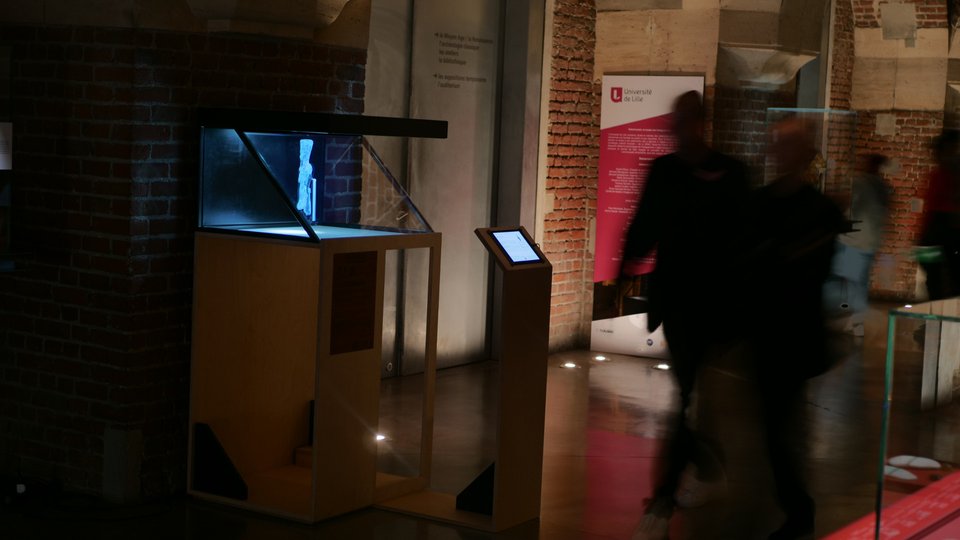
Digitalization for education and cultural heritage
Launched by the Holomouseio project, with the University of Lille, holographic mediation is a real opportunity for museums and scientific education spaces.
The digitalization of archaeological or scientific artefacts makes it easy to create applications to explain them, enhance their value and transmit knowledge to the public.
Early humans roaming Northern France
With the Inrap des Hauts-de-France, discover the life of the early settlers in Northern France trough the artefacts, sculptures and objects they left behind.
The Inrap is the french Institute for preventive archeologic research, looking for important remains and artefacts before a construction site starts building.
For this project of exhibition, the Inrap have digitzied a part of its collections thanks to photogrammetry technologies. This pieces are telling stories about the early humans roaming through the region during prehistoric times. This hundred thousand years long period left us traces of a rich culture of tool making, hunting and crafting in these hunter-gatherer societies.
Credits
- Conception : Estelle Bultez
- Inrap archeologist : Pascal Depaepe, Thierry Ducrocq, David Hérisson, Jean-Luc Locht, Clément Paris, Pierre Antoine – CNRS
- Partners : Drac Hauts-de-France, département de la Somme, CNRS, Amiens métropole.
- Photogrammetry : Nicolas Lissarrague - DeVisu UPHF
- Production : Holusion
Digitalization of “Le Pied de Croix de Saint-Bertin"
E.Thesaurus is based on the development of a methodology for the acquisition of goldsmith's items with a high level of detail and reflective elements. This method is based on a 3D photogrammetric reconstruction from images illuminated with cross-polarized light. The project includes a communication component aimed at the public and students via the holographic format.
Photogrammetry is a technique that consists of making measurements in a scene, using the parallax obtained between images acquired from different points of view.
Project leader and participants:
- Marc Gil (University of Lille, IRHiS)
- Christine Aubry (University of Lille, IRHiS)
- Pierre Hallot (University of Liège, labo LNA/DIVA)
- David Strivay (University of Liège, Centre européen d’Archéométrie)
- Frédéric Tixier (University of Lorraine-Campus de Nancy, CRHUL)
- Romain Saffré ("Musée de l’hôtel Sandeli"n, Saint-Omer)
- Sophie Dutheuillet de La Motte (Conservator, Palais-des-Beaux, Lille)
- Florence Raymond (Conservator, new medias and digital tools, Palais des Beaux-Arts, Lille)
- Christine Descatoire (Conservator, Musée de Cluny, Paris)
- Julien Maquet (Conservator of the "Trésor de la cathédrale de Liège")
- Thibault Guillaumont, Holusion (Plaine images, Tourcoing)
Scientific mediation around trilobites
Hologram photogrammetry presentation video.
Discovery of a fossil of rolled trilobite , an extinct species of marine arthropod, and highlighting what constitutes it.
A prototype made by Thibault Guillaumont for Holusion on the occasion of the "Fête de la Science" in Lille in 2019.
Scientific Credits: Laboratory UMR 8198 Evo-Eco-Paleo (EEP) in Lille.
Catherine Crônier / Jessie Cuvelier
Holographic display: Iris 32
The Impressionism movement. Renoir in "Musée Fournaise"
On the inconic place where the "Déjeuner des Canotiers" was painted, Renoir returns to present his life as an artist.
100 years after his disappearance, Renoir returns to Chatou at the Maison Fournaise.
He is embodied by a hologram on a human scale and recounts his first successes and his first setbacks in the world of Impressionist painting.
Scientific Credits: Musée Fournaise, Anne Galloyer
Production: Holusion / Christophe Leray (scenography)
Holographic display: Iris 75 and customized set